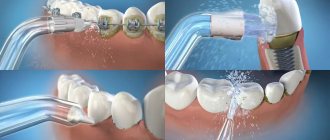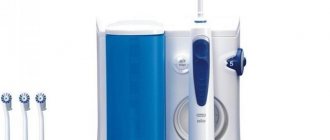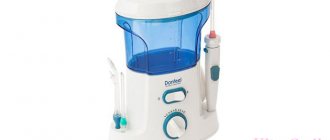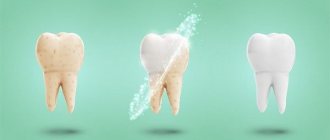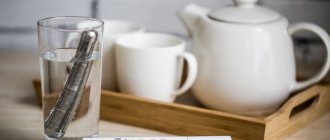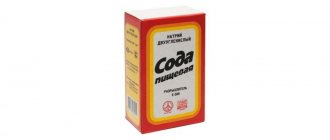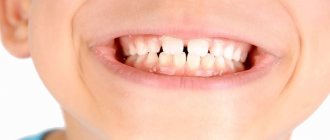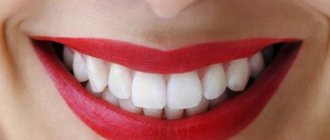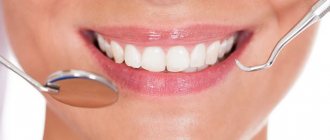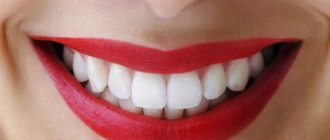Good oral hygiene is extremely important not only to maintain an aesthetically attractive appearance, but also to maintain the healthy functioning of the body as a whole. Currently, there are many functionally useful devices for hygienic treatment of the oral cavity. One such device is an irrigator.
In this article we will try to tell you in detail about how to properly use an irrigator to clean your teeth and how often you can use an oral irrigator .
Why do you need an irrigator and how does it work?
An irrigator is essentially a device that treats the oral cavity using a focused jet of water supplied under high pressure. The enhancing effect is the pulsating mode of liquid supply. As a result of this treatment, full-scale removal of contaminants occurs both from the surface of the teeth and gums, and from the interdental spaces.
In connection with the popularization of irrigators, consumers have a number of questions, the most pressing of which are: how to properly use an irrigator for cleaning teeth and how often can you use a dental irrigator ?
At what age can children use an irrigator? In order to answer these and many other questions related to the use of this relatively new device for us, it is necessary to consider in more detail some of the nuances.
Medicinal use
Medical irrigators have long been widely used in dentistry for almost all procedures, often without pressure, but with the purpose of supplying water “for spitting.”
For medicinal purposes, a household irrigator can be used:
- with increased plaque formation on the teeth;
- at the initial stage of gingivitis;
- with chronic periodontitis without exacerbation or with mild exacerbation in the initial stage.
For therapeutic purposes, instead of water, antiseptic liquids are used (solution of furatsilin, miramistin, chrolhexidine, special elixirs). The use of herbal decoctions and tinctures is limited by most device manufacturers, due to possible breakdown of the irrigator due to blockage of the passages.
Applications outside dentistry
With the increasing popularity of the device, it turned out that the irrigator is used not only in dentistry. Many people believe that using an irrigator is better to remove bacteria from the surface of the tonsils than with regular rinsing. The use of irrigators for irrigation with medicinal solutions is useful:
- tonsils for chronic tonsillitis;
- the back wall of the throat for pharyngitis (during this procedure, breathing is held for a short inhalation, and the root of the tongue should be pressed tightly, as when gargling).
When reviewing articles and user reviews from the Internet, it also turned out that there are craftsmen who, in case of chronic tonsillitis, used an irrigator with an attachment for periodontal pockets to wash out purulent plugs from the tonsils. Theoretically, with certain skills, this can be done. But it’s better to trust a specialist.
In otolaryngology, the removal of plugs from lacunae is carried out using a special curved needle with a blunt end. It is injected into the lacuna of the tonsils and under pressure with a medicinal solution, the pathological contents are washed out of them. If for this purpose you do not skillfully use a nozzle designed for rinsing gum pockets, you can, instead of rinsing it out with water pressure, on the contrary, drive the plugs deeper.
Important! Do not try to wash out tonsil plugs yourself; there are otolaryngologists for this.
Indications for use of the irrigator
- Prevention of caries. Due to the fact that the effect of the irrigator extends to the most inaccessible areas of the oral cavity, it becomes a good prevention of many dental diseases, the main and most common of which is caries. The irrigator is able to clean both the surface of the front teeth and wisdom teeth, which are the most inaccessible, and therefore are recognized as the most vulnerable dental units;
- Prevention of gum disease. A focused and dense stream supplied by the irrigator has a massaging effect on the surface of the gums, which in turn serves as a good prevention of many diseases, including bleeding;
- Care of implantation, prosthetics and braces systems. The irrigator is capable of efficiently and quickly processing both the surface of prosthetic elements and the cavities hidden behind them;
- Prevention of gingivitis. A massaging jet of water stimulates and restores impaired blood supply to soft tissues. This procedure is most relevant for pregnant women who have the greatest tendency to develop this disease;
- Prevention of unpleasant odor. The irrigator efficiently washes away food debris, which is a source of unpleasant odor, even from the most inaccessible areas of the oral cavity;
- A history of nasopharyngeal diseases. This direction is an additional option and requires special nozzles suitable for rinsing the nasal passages. Such treatment is carried out only on the recommendation of an otolaryngologist.
Do-it-yourself flow irrigator
Another way to make an irrigator with your own hands is a flow-through version of the device. Its difference is that there is no possibility of using a special liquid, and the oral cavity is rinsed with ordinary water. To assemble the structure, you must perform the following steps:
- Prepare a nozzle whose diameter will correspond to the size of the faucet outlet.
- Screw a thin silicone or rubber tube to the nozzle.
- Open the water and start using the device.
- This method is convenient for cleaning teeth and interdental spaces. Even children can use the hose with nozzle.
An example of a homemade irrigator
Contraindications to using an irrigator
There are literally no such contraindications. There are some restrictions on the use of this device.
Limitations of using the irrigator:
- Children under six years of age;
- Excessively developed gag reflex;
- Diseases of the oral cavity during exacerbation;
- Postoperative conditions;
- A history of serious neurological and cardiovascular diseases;
- increased sensitivity of teeth and bleeding gums.
Contraindications for irrigation
Despite the broad indications for irrigation, there are conditions in which its use is undesirable or limited. These include:
- Acute severe periodontitis with suppuration and a high degree of bone tissue melting. The use of irrigators can increase the hematogenous spread of infection and bone destruction.
- Severe bleeding gums. High blood pressure will increase the fragility of blood vessels, and bleeding may turn into hemorrhage.
- You should not use irrigation within 24 hours after tooth extraction and some dental operations (always check such nuances in the dentist’s chair).
The use of an irrigator in young children is limited due to their lack of brush skills. You can use the irrigator from the age of 6, under parental supervision.
Types of irrigators
- Stationary. The jet power of such an irrigator should not be less than 550 kPa. The stationary mounting device has a softer and more comfortable system for switching modes, which is an undeniable advantage if the users include children, the elderly and people with disabilities. The optimal level of jet pulsation corresponds to 1200 pulsations. The device is mounted on a horizontal surface. A relative disadvantage of the installation can be considered its rather large dimensions. In this regard, stationary irrigators are installed in the bathroom. Power is supplied from the electrical network. A distinctive feature is the large volume of the liquid reservoir, a powerful motor and the creation of high pressure when supplying liquid.
- Portable irrigators. The advantage of such irrigators is their complete autonomy due to the ability to operate on a battery, which allows you to take the device with you on trips. The power ratings of a portable device should not be less than 520 kPa. Changing operating modes occurs in a stepwise manner.
- Flow irrigators. The simplest device installed directly on the water tap. The force of the jet is regulated by the mixer valves.
- Mechanical irrigators. Water pressure is created by pumping by pressing the built-in piston.
In addition to the installation method, irrigators differ in the type of jet supplied.
Devices for children
Choosing the right oral care device becomes more difficult if it is used by children in addition to adults. It is not advisable to use the device to clean the teeth of children under 6 years of age.
Manufacturers of irrigators equip the device with special attachments for children. However, they are often not necessary to use. The main condition when brushing teeth with an irrigator in children is to control the power of the supplied jet. It is not advisable to purchase devices with a pulsating operating mode for children, as it can damage the fragile enamel of baby teeth.
There is no need to purchase heavy equipment for small users, as they will quickly get tired of the procedure. The cleaning process is carried out under adult supervision.
Types of irrigators by type of jet supplied
- Monojet. They represent a continuously supplied flow having the same power and direction;
- Turbo flow with pulsation. The most modern technology, characterized by the supply of micro-hydro-impact jets that target specific areas.
The optimal level of jet frequency is considered to be 1200 pulsations per minute. Some models allow you to reproduce frequencies in excess of 1700 beats.
The classic volume of the reservoir, designed for one session (one cleaning) is 150-200 ml of water for portable and 500 ml more for stationary irrigators. The correct selection of the cleaning attachment plays an important role.
Which nozzle to choose for using an irrigator
There are several different attachments for the irrigator, the choice of each of which depends on the required purposes:
- Standard. Designed for treating teeth and gums without signs of disease.
- Orthodontic. It will be the best option for people using any type of prosthetic systems. This attachment allows you to remove plaque and dirt under bracket systems and bridge retainers with the highest quality possible.
- Periodontal attachment. It is considered a highly targeted accessory. It is used only at minimum power levels and is necessary for cleaning interdental spaces.
- Implantation attachment. As the name suggests, it is used in cases when it comes to the need for hygiene of teeth with implants and crowns. A distinctive feature is the presence of 3 tufts of bristles on the tip.
- Tongue treatment attachment.
- Brush type nozzle. It should be noted that such an attachment cannot act as an absolute substitute for a toothbrush.
We should also highlight the additional function of the irrigator. The essence of this direction is preventive measures in the treatment of sinusitis and rhinitis. In this case, a specialized nozzle and an individually selected mode are used.
Making your own irrigator from a syringe
An irrigator can be made from a syringe. To do this you will need the following tools:
- 5 ml or 20 ml syringe (volume depends on personal needs);
- sandpaper for grinding down the needle point;
- mouth rinse.
Tools for making a DIY irrigator
The device is quite easy to make yourself. To do this you will need to do the following:
- Take the needle from the syringe and carefully grind off the tip with sandpaper. You can use sharper tools, such as a knife, to remove the pointed part. Next, you need to sharpen the damaged surface so that when using a homemade device, family members do not damage the gums.
- Carefully bend the remaining part of the needle so that it resembles a standard nozzle in shape.
- If the needle cannot be bent, you can heat it a little over the fire and carefully bend it into the required shape.
- To use a home-made device, you need to assemble the syringe, remove the plunger and pour in the used teeth cleaning product.
- Then insert the piston into the syringe and, using gentle pressure, provide the necessary pressure for the jet. In this way, the interdental spaces are cleaned from food debris, protecting teeth from plaque.
Option for a homemade irrigator from a syringe
Some masters use a speed regulator from a simple medical dropper instead of a needle. To do this, cut off the required length of the nozzle and secure it with wire. The regulator can be used to adjust the fluid supply power. The homemade device is not recommended for use for cleaning the mouth of children.
Syringe with dropper regulators
What liquid to pour into the irrigator
To refill the device, liquids are used, which, depending on the composition, have one or another effect.
Main types of compositions:
- Fluoridating. Aimed at strengthening tooth enamel;
- Therapeutic and prophylactic. Contain antiseptic additives, mostly of plant origin;
- Refreshing. The composition of such liquids includes menthol and eucalyptus, which help freshen breath;
- Antiperiodontal. Contains various biooxidants and anti-caries components;
- Hypoallergenic. They have a neutral composition, suitable for people prone to allergic reactions.
Operating principle
The essence of the principle of operation of the irrigator is quite simple: liquid (water or solution) is poured into a special container of the device, the compressor creates pressure, and when you press the button, a stream escapes from the tip. Getting on the teeth, gums, tongue, palate, it “knocks down” microparticles adhering to the mucous membrane and washes them away. The person can only spit out the waste liquid.
Important: the liquid in the device is supplied under pressure, so people who have any acute inflammation of the mucous membranes of the gums, tongue, cheeks and lips are not recommended to use the irrigator for a hygienic procedure.
The most popular balms for irrigator
“Terasol” (antimicrobial effect), “Denfil” (alcohol-free balm, acceptable for use in children), “Asepta” (caries prevention), “Irix” (non-foaming balm with menthol to freshen breath).
The use of tap water is extremely undesirable due to the risk of device failure, since this water contains sedimentary components.
If it is impossible to use balsamic liquids, you can use boiled or special purified water.
Which dental irrigator to choose
Basically, irrigators are divided into 2 types: stationary and mobile. Stationary irrigators have a large capacity for liquid (about 1000 ml), operate from the mains and their main distinguishing feature is high power. Mobile (portable) irrigators are light in weight, the volume of liquid is almost 2 times less than that of stationary ones (400-500 ml) and operate on batteries.
If you plan to mainly use the irrigator at home, then it is certainly better to buy a stationary irrigator, since you do not need to buy batteries for it, and the large volume of the liquid reservoir is enough for several uses, or for use by two people.
If you travel often, it is better to take a portable irrigator model, since it takes up little space and does not require an outlet to operate.
Where can I buy
Carefully study the composition and expiration date before purchasing.
Professional solutions for irrigators are sold by representatives of pharmaceutical companies, which, as a rule, work exclusively with dental clinics.
Household liquids are freely available. Today, they can be easily purchased in household chemical and hygiene stores, pharmacies, and also in online stores.
When purchasing liquid for an irrigator by any means, you should pay special attention to its expiration date, manufacturer and composition. This will avoid the use of low-quality products that may be produced by illegal companies.
How often can and should you use an irrigator?
In order to understand how many times a day you can use the irrigator, you need to determine the ultimate purpose of using the device. So, for normal oral hygiene, you can use the irrigator once a day, or every other day. The use of specialized balms for prophylactic purposes is allowed no more than 2-3 times a week.
Excessively frequent use of an irrigator can lead to the opposite consequences, namely, thinning of the enamel layer and expansion of gum pockets in areas of periodontitis.
How to use an irrigator: step-by-step instructions
The essence of the action of irrigators is mostly identical. Below are detailed instructions on how to use the irrigator :
- It is necessary to consult a dentist to select the optimal mode of operation of the irrigator, the type of nozzle and the liquid used.
- It is advisable to use an irrigator after using a toothbrush and dental floss.
- You need to choose the most suitable mode. Experts usually recommend starting to get acquainted with the device with minimal power, gradually increasing it as you get used to it. On average, the adaptation period lasts about 7 days.
- The nozzle of the nozzle is directed so that the supplied jet is perpendicular to the surface of the teeth and gums.
- Each dental unit is treated on all sides and adjacent areas of the gums.
- If a special liquid was used that included additional additives, the mouth must be rinsed with water immediately after completing the procedure.
Additional recommendations for using the irrigator:
- The optimal time to use the irrigator is in the evening;
- The average time required for high-quality cleaning of the entire oral cavity is about 10 minutes;
- People with prosthetic structures are advised to use an irrigator after each meal;
- It is not recommended to use an irrigator immediately after flossing (if the gums have been injured by it.) This is due to the risk of additional injury to the gums;
- During the procedure, the tongue is pressed against the upper palate to prevent fluid from entering the respiratory tract;
- Processing is carried out smoothly, avoiding sudden movements. If unpleasant sensations occur, the power of the jet is reduced.
Oral irrigator: application
This is the only device that can easily cope with tasks that a toothbrush cannot do:
- Easily, and most importantly – safely, removes plaque between teeth and in gum pockets. The accumulation of plaque in these areas is a predisposing factor for cervical caries, caries on contractual surfaces, as well as gum disease.
- The use of an irrigator is mandatory for patients undergoing orthodontic treatment, that is, wearing braces, dentures (especially long ones), crowns, veneers and implants. All these structures make oral hygiene difficult, but require special care.
- A jet of water under pressure cleanses periodontal pockets while simultaneously massaging the gums, which has the best effect on their health and strengthening. These measures help fight bleeding.
No toothbrush or toothpaste provides 100% removal of plaque; gradually it accumulates, mineralizes and turns into stone. The irrigator does not replace a brush and paste; these products only improve hygiene indicators, while having a positive effect on the gums and blood supply to them.
High-quality hygiene, gum massage - measures to prevent periodontitis - serious inflammation of the gums. Even with an existing disease, the use of an irrigator helps to achieve stable remission.
How to clean the waterpik after use
After each use of the irrigator to clean your teeth, you must pour out the remaining liquid from the reservoir so that bacteria and germs do not accumulate there. After cleaning, you need to unplug the device, remove the nozzle and pour the remaining liquid from the reservoir. Next, you need to thoroughly rinse and dry the irrigator; the nozzle should be washed with soap and water and wiped thoroughly with a napkin. It is better to rinse the irrigator under warm water, as hot water can damage the body of the device.
Varieties
Today there are a large number of irrigators, differing from each other in various parameters. Devices are divided into portable and stationary, powerful and not very powerful, with one or more nozzles and modes, with and without microbubble technology, with a water tank and with a connection to a tap, as well as with built-in dental floss, like JETPIK irrigators, in several times increasing the effectiveness of teeth cleaning. Do not also forget that each device has a certain warranty period, depending on the policy of the manufacturer. Read about how to choose the best irrigator in our other articles.
Reliable and convenient irrigator for the whole family Hydro Floss Kitty Waterjet
Can two people use an irrigator?
When answering the question whether it is possible to use the irrigator together , it is important to mention that the device itself is designed for use by all family members. Only the nozzles themselves are individual. Just like a toothbrush, they are a means of personal hygiene. In this regard, when purchasing an irrigator, you need to pay attention to the number of nozzles included in the package and, if necessary, purchase the missing ones.
Nozzles should be replaced at least every 3-6 months.
Top 10 rating according to KP
ACleon TF600
ACleon TF600. Photo: ACleon
The main difference between this model and others is the built-in ultraviolet lamp, which reliably disinfects all attachments. The set includes seven nozzles for jet cleaning of teeth, tongue, periodontal (for gums) and orthodontic (for braces, implants and crowns). The pulsating jet is good for massaging the gums, improving blood circulation and reducing bleeding.
The irrigator itself operates from a regular power supply, with a maximum jet pressure of 900 kPa, and the number of pulses reaches 1,700 per minute. The irrigator operates in 17 modes, which allows you to choose the most comfortable mode for yourself. The only downside is that you can only use this stationary model at home; you won’t be able to take the irrigator on a trip.
Built-in ultraviolet lamp, high build quality and long service life, large number of nozzles, large water tank (600 ml)
Works only on mains power, so cannot be used while traveling
Good to know
Why gums become inflamed and how to cure them
So Wash Family
So Wash Family. Photo: So Wash
This unique irrigator model works without electricity or batteries, connecting directly to the tap. At the same time, even the most inexperienced can connect the device without much effort, and after the procedures it does not need to be disconnected each time. You can independently regulate the water temperature, and the power of this irrigator is 30% greater than that of electric models. You also don’t need to constantly add water, which saves time significantly, but you won’t be able to fill in medicinal solutions and rinses. The irrigator itself is very compact, so it is easy to take with you when traveling. The model is equipped with a patented safety valve, so there is no need to worry about water pressure surges. The set includes 4 single-jet nozzles and 4 three-jet periodontal nozzles (microbubble technology is used when streams of water are saturated with air bubbles).
Connects directly to the faucet, more powerful than electric irrigators, eight nozzles (for four family members), virtually silent, suitable for use by the whole family, 3 years warranty
High price, impossibility of using medicinal solutions and rinses instead of water
Revyline RL 700 white/black
Revyline RL 700. Photo: Revyline
The modern model of the irrigator with a stylish, laconic design is presented in two colors - white and black, so it will decorate any interior. The irrigator is made of durable plastic and equipped with touch controls, as well as a capacious liter tank that turns into a protective case. The set includes six attachments - two standard, orthodontic, for caring for implants and for cleaning the tongue.
The maximum jet pressure reaches a power of 860 kPa, which is very convenient when cleaning braces. The irrigator is equipped with a hydromassage function, useful for the prevention of periodontitis and gingivitis. The portable model is easy to carry with you in your bag when going on a long trip.
Stylish design, large reservoir (1 liter), touch control, large selection of attachments, ability to take on trips
High price, no wall mounting
WaterPik WP-660 Aquarius Professional
WaterPik WP-660 Aquarius Professional. Photo: WaterPik
This model, despite its high cost, is in great demand among buyers. This pulse irrigator operates in two modes - pulsating and constant, and water is supplied as a stream or spray, which allows you not only to treat the entire oral cavity, but also to gently massage the gums without injuring them. The set includes seven attachments, including a tongue attachment and an orthodontic attachment, while the attachments themselves rotate 360 degrees. Another advantage is the large reservoir with a capacity of 650 milliliters.
Effective oral care, 360 degree rotating nozzle, minute timer, large selection of nozzles, large reservoir
High price
show more
Panasonic EW 1211A
Panasonic EW 1211 A. Photo: Panasonic
This irrigator model boasts microbubble technology: unlike a regular jet, small water jets are saturated with air bubbles, so plaque and dirt are removed without residue, while providing a bactericidal effect. The model has three modes: Jet, which knocks out food debris from the interdental space, Regular AirIn for massage and cleaning of the gums, SoftAirIn, which provides a comprehensive massage of the oral cavity. The irrigator is also equipped with two rotating nozzles and wireless charging, and the rubberized body fits comfortably in the hand. The compact model fits easily even in a small bag, so it is convenient to take the irrigator with you on a trip.
Multi-bubble technology, 3 modes, wireless charging
Small water tank capacity
show more
Philips AirFloss Ultra HX8432
Philips Sonicare AirFloss Ultra HX8438/03. Photo: Philips
A compact and stylish model that not only perfectly cleanses every millimeter of the oral cavity, but also massages the gums, and is also recommended for sensitive teeth. A distinctive feature of this model is the use of the latest Microburst technology (a stream of air is mixed with tiny drops of water and supplied under high pressure), which does not damage the enamel and mucous membranes. There are three operating modes, and you can clean your entire mouth in just a minute.
The design is well thought out: the body of the irrigator fits comfortably in the hand, and it is convenient to pour liquid through a wide hole. The built-in battery, although it takes a long time to charge, holds a charge for more than a week.
Customizable injection function, auto-spray mode, wireless charging, new improved nozzle, stylish and ergonomic design
High cost, very small water tank volume
show more
B.Well WI-911
B.Well WI-911. Photo: B.Well
This lightweight and compact, yet powerful irrigator model operates in three modes: Normal (effective cleansing), Soft (for sensitive teeth) and Pulse (healing gum massage). Rotating attachments remove food particles even in the most inaccessible places, but there are only two replaceable attachments in the set, and orthodontic attachments for caring for braces and crowns must be purchased separately. The lithium-ion battery lasts up to 70 minutes of continuous use, and charging itself is wireless.
Auto shut off, wireless charging, suitable for sensitive teeth, virtually silent
The housing is not completely sealed, the volume of the water tank is small, orthodontic attachments have to be purchased separately
show more
Rio Water Flosser & Oral Irrigator 2
Irrigator Rio DCIR2. Photo: Rio
This portable irrigator model with a built-in rechargeable battery is in great demand among buyers due to its price-quality ratio. Stylish and ergonomic design, high power, capacious battery - these are the main advantages of the irrigator. The model operates in three modes: Normal (to remove food particles and plaque), Soft (for sensitive teeth and gums) and Pulse (to massage the gums and rinse gum pockets). The manufacturer promises an improvement in the condition of the gums and a reduction in bleeding within 10 days.
Three operating modes, stylish design, value for money
Small volume of the water tank, weak jet pressure when the charge runs out, flimsy lid on the tank
How to use an irrigator: summary
If you follow all the rules and recommendations, the irrigator can become an indispensable hygiene product for the whole family. Its massaging and washing properties can help, if not eradicate, then minimize many problems associated with the condition of the oral cavity.
In this article, we tried to answer your question: how to properly use an irrigator to clean your teeth and mouth . In order for the use of an irrigator to bring maximum benefit, it would be advisable to consult a dentist.
Rules for caring for the device
Like all electrical appliances, irrigators require special care, but the rules are simple:
- Do not immerse it in water, otherwise the parts may rust or a short circuit may occur.
- It is forbidden to use unboiled water, only filtered and warm.
- The attachments need to be thoroughly washed; some devices are equipped with a UV sanitizer designed to disinfect replaceable attachments.
- The irrigator should be stored in a dry place.
- After using the special solution, rinse the nozzles thoroughly.
- Not all rinses are suitable for irrigators; these must be special solutions.
Dentists at the Axioma Dental clinic remind you that an irrigator is a device that will help improve oral hygiene, but does not replace the use of conventional means and objects. A stream of water or a special solution will remove plaque in places where a toothbrush cannot reach. Additionally, it will improve blood circulation in the gums and strengthen them, which reduces the likelihood of periodontal disease.
Sources:
- Medical and social aspects and prevention of periodontal diseases among students, 2007
- Evaluation of orthodontic treatment of adult patients with dentoalveolar anomalies and inflammatory-dystrophic periodontal diseases, 2006
- Complex diagnosis and treatment of oral candidiasis caused by dentures against the background of intestinal dysbiosis, 2007
Expert author:
Makanina Lina Viktorovna
Dentist-therapist
The information presented in this article is provided for reference purposes and does not replace the advice of a qualified specialist.
At the first signs of illness, you should consult a doctor.
Tell us about us:
